How to Grow Honeydew: Simple Tips for First-Time Gardeners
- March 4, 2024
- 0 comment
Honeydew, a refreshingly sweet and hydrating fruit, is a delightful addition to any garden. Known for its smooth, pale green skin and succulent flesh, honeydew melons are not only delicious but also packed with vitamins and minerals. Growing honeydew can be a rewarding experience for both novice and experienced gardeners. This guide will walk you through the steps to successfully cultivate honeydew melons in your garden.
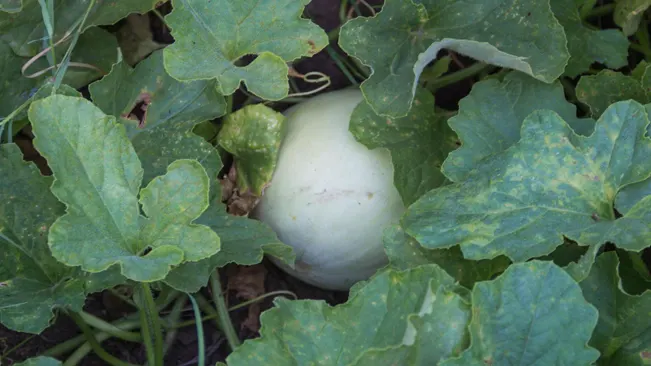
Nutritional Benefits of Honeydew
| Benefit | Description |
|---|---|
| Nutritional Value | High in vitamins and minerals like Vitamin C, Vitamin B6, potassium, and folate. |
| Hydration | Contains a high water content, making it excellent for hydration, especially in hot weather. |
| Low in Calories | A great option for weight management, as it is low in calories but high in nutrients. |
| Digestive Health | The fiber content in honeydew aids in digestion and helps prevent constipation. |
| Healthy Skin | Vitamin C and antioxidants in honeydew contribute to healthy skin by supporting collagen production and protecting against UV damage. |
| Supports Heart Health | Potassium helps control blood pressure, and the fiber, vitamin C, and choline in honeydew support heart health. |
| Boosts Immune System | Vitamin C and other antioxidants in honeydew help strengthen the immune system. |
| Blood Sugar Regulation | Honeydew has a low glycemic index, which helps regulate blood sugar levels. |
| Eye Health | Contains lutein and zeaxanthin, antioxidants that are known to help prevent eye diseases. |
| Anti-inflammatory Properties | Contains compounds that have anti-inflammatory properties, which can help reduce the risk of certain chronic diseases. |
Choosing the Right Variety
Before you start, it’s important to select the right variety of honeydew for your climate and gardening space. Popular varieties include ‘Earlisweet,’ ‘Orange Flesh,’ and ‘Tam Dew.’ Consult with local nurseries or agricultural extensions to find the best variety for your region.
Earlisweet

- As the name suggests, ‘Earlisweet’ is known for its early maturation. It’s ideal for regions with shorter growing seasons. This variety produces small to medium-sized melons with sweet, pale green flesh. It’s a great choice if you’re looking for a quick harvest.
Orange Flesh
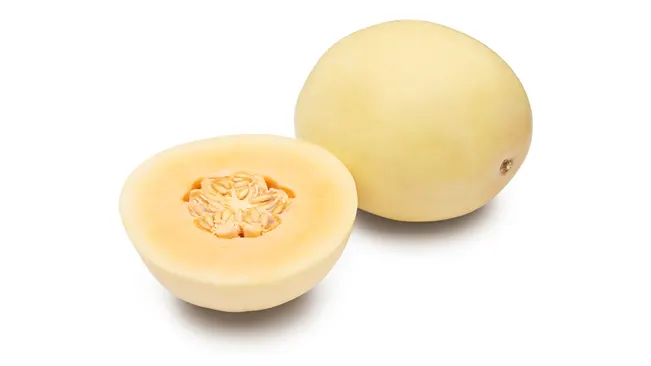
- This variety is distinctive due to its orange-colored flesh, which is not common in typical honeydews. It offers a rich, sweet flavor and a slightly firmer texture compared to the classic green-fleshed varieties. ‘Orange Flesh’ is a good option if you’re looking to try something different in taste and appearance.
Tam Dew
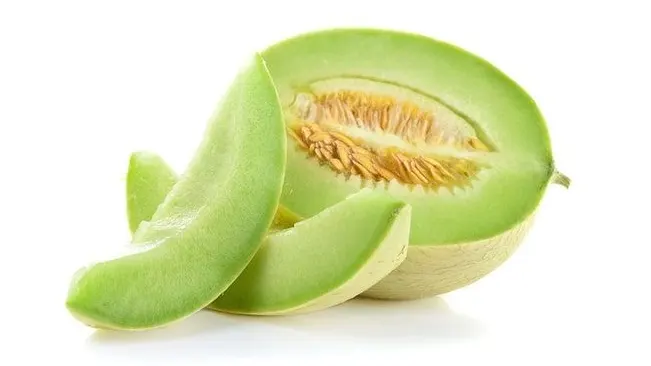
- A variety known for its exceptionally sweet flavor and fine texture, ‘Tam Dew’ melons are typically round with a creamy, white to slightly greenish rind. They are well-suited for warmer climates and have a good resistance to common melon diseases.
When choosing a variety, consider the following factors:
- Climate Compatibility: Some varieties are more heat-tolerant, while others can withstand cooler temperatures better. Check the variety’s suitability for your local climate.
- Space Requirements: If you have limited space or are gardening in containers, look for compact or bush-type varieties.
- Disease Resistance: Some varieties have been bred for resistance to common diseases. This can be a significant advantage, especially for organic gardeners.
- Harvest Time: Consider the maturity time if you have a short growing season. Early-maturing varieties can be harvested sooner.
- Taste and Texture Preferences: While most honeydews have sweet, juicy flesh, the texture and sweetness levels can vary. Some may prefer a firmer or softer texture, or a sweeter or milder taste.
Planting
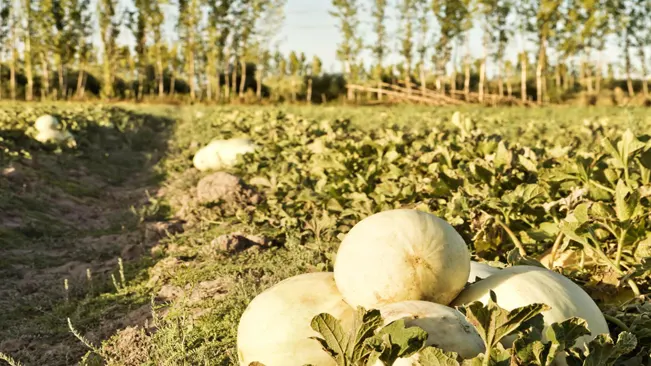
Timing
- Understanding Your Climate: The key to successful honeydew planting is understanding your local climate and frost dates. Honeydews are warm-season crops and are sensitive to frost. Planting should occur when you are confident that the last frost has passed. You can check local weather services or agricultural extensions for accurate frost date information.
- Soil Temperature: Soil temperature is crucial for seed germination. Honeydew seeds require a soil temperature of at least 65°F (18°C). You can use a soil thermometer to check the temperature at planting depth. In cooler climates, you can warm the soil before planting using black plastic mulch or row covers.
Soil Preparation
- Soil Quality: Honeydews prefer rich, loamy soil. The goal is to create an environment that holds moisture but also drains well to prevent waterlogging, which can lead to root diseases.
- pH Level: Ideally, the soil pH should be between 6.0 and 7.5. If necessary, you can modify the pH with lime (to raise pH) or sulfur (to lower pH) based on a soil test.
- Adding Organic Matter: Incorporating organic matter like compost or well-rotted manure improves soil fertility and structure. This step is particularly important if your soil is heavy clay or very sandy. Organic matter also helps retain moisture and provides essential nutrients as it breaks down.
Spacing and Planting
- Method: Planting in raised beds or on hills helps improve drainage and warms the soil faster, which is beneficial for the growth of honeydew. Hills should be about 12 inches high and 24 inches wide.
- Spacing: Proper spacing is important to give each plant enough room to grow. Space the seeds or seedlings about 2 feet apart. If you are planting multiple rows, keep the rows 4-6 feet apart to allow for the spread of the vines and ease of access for maintenance and harvest.
- Depth and Quantity: Plant seeds about 1 inch deep in the soil. It’s a good practice to plant 2-3 seeds per hole and later thin out to the strongest seedling. This ensures that you will have at least one strong plant per spot, even if not all seeds germinate.
Caring for Your Plants
Watering
Proper watering is crucial for the growth of healthy honeydew melons. Here are some detailed tips:
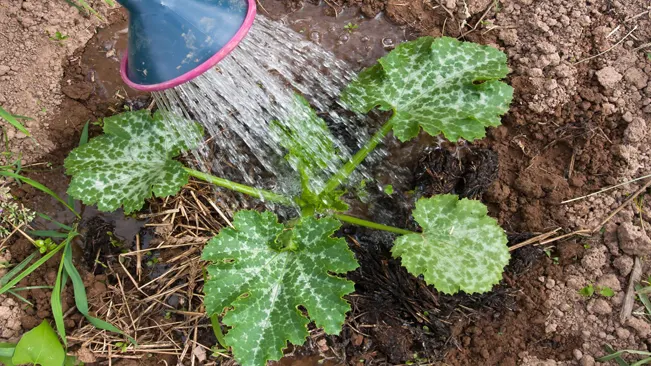
- Consistency: Honeydew plants require consistent moisture levels to develop their fruit. Irregular watering can lead to issues like fruit cracking or poor development.
- Method: Drip irrigation or soaker hoses are ideal as they deliver water directly to the roots and minimize water waste. This method also helps keep the leaves dry, reducing the risk of foliar diseases.
- Monitoring Soil Moisture: Check the soil moisture regularly. The soil should be moist but not waterlogged. Overwatering can lead to root rot and other fungal diseases.
- Mulching: Applying a layer of organic mulch around the plants helps maintain soil moisture and reduces the frequency of watering.
Fertilizing
Fertilization is important to provide the necessary nutrients for the growth of honeydew melons:
- Type of Fertilizer: A balanced fertilizer (like a 10-10-10 NPK ratio) is generally recommended. You can also use compost or well-rotted manure as organic options.
- Application: Apply fertilizer according to the package instructions. Avoid applying it directly to the plant stems or leaves to prevent burn.
- Phases of Growth: Early in the plant’s growth, a nitrogen-rich fertilizer can promote healthy vine growth. However, as the plant starts to flower and set fruit, switch to a phosphorus and potassium-rich fertilizer to encourage fruit development.
Weeding
Keeping the area around honeydew plants weed-free is important for several reasons:
- Competition for Resources: Weeds compete with your honeydew plants for water, nutrients, and light.
- Pest and Disease Harbor: Weeds can harbor pests and diseases that may transfer to your melon plants.
- Weeding Techniques: Hand weeding is often the safest method around delicate melon plants. It’s important to weed regularly to prevent weeds from establishing and becoming more difficult to remove.
- Mulching for Weed Control: Organic mulches, like straw or wood chips, not only retain moisture but also suppress weed growth. They decompose over time, adding nutrients to the soil.
Pollination
Understanding Pollination in Honeydew Melons
Honeydew melons, like many other melon varieties, have separate male and female flowers on the same plant (a condition known as monoecious). For fruit to set, pollen from male flowers must be transferred to the female flowers.
- Male Flowers: These typically appear first on the vine. They have a slender stem and a stamen that produces pollen.
- Female Flowers: These have a small swelling at the base, which is the ovary that will grow into a melon once pollinated.
Why is Pollination Important?
- Without pollination, the female flowers will not produce fruit. In nature, this process is usually carried out by bees and other pollinating insects. They transfer pollen as they move from flower to flower in search of nectar.
Hand Pollination
- A Solution to Pollination Challenges If you’re growing honeydew in an area with limited bee activity or in a controlled environment like a greenhouse, hand pollination can be a practical solution.
Steps for Hand-Pollinating Honeydew Melons
- Identify the Flowers: First, identify the male and female flowers. The male flower is on a thin stem, while the female has a bulbous base.
- Collect Pollen: Gently shake the pollen from a male flower onto a small brush or use your finger. The best time to do this is in the morning when the flowers are open and the pollen is most viable.
- Transfer Pollen to Female Flower: Carefully dab the pollen onto the center of the female flower. Make sure to transfer the pollen to the stigma in the center of the flower.
- Repeat if Necessary: You may need to repeat the process over several days, as new flowers open.
Harvesting
Harvesting Timing
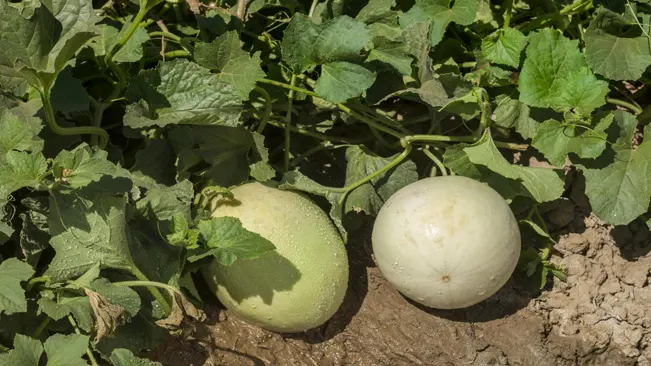
- Maturity Indicators:
- Color Change: The skin of the honeydew melon will change from a greenish to a creamy or slightly golden hue as it matures. This color change is a key indicator that the melon is ready for harvest.
- Surface Texture: The surface of the melon becomes slightly waxy when it’s ripe.
- Fragrance: A ripe honeydew emits a sweet, slightly musky fragrance. You might notice this when you’re close to the melon.
- Blossom End Softness: The end of the melon where the flower was (opposite the stem end) should yield slightly to gentle pressure. This softness indicates that the inside is likely to be ripe and juicy.
- Stem Appearance: The stem end may show slight cracking around where it attaches to the vine. This is another sign that the melon is ripe.
- Days to Maturity:
- Typically, honeydew melons take about 80-100 days to reach maturity after planting. However, this can vary based on the variety and growing conditions.
Harvesting Technique

- Using the Right Tool:
- Use a sharp knife or pruning shears for harvesting. A clean cut helps to prevent damage to the vine and the remaining fruits.
- Cutting Method:
- Gently lift the melon and cut the stem close to the fruit. Leave about an inch of stem attached. This helps in preventing the entry of pathogens through the cut area, which can lead to quicker spoilage.
- Handling After Harvest:
- Handle the harvested melons gently to avoid bruising. Bruising can lead to quicker deterioration and can also affect the flavor.
- Post-Harvest Storage:
- Honeydew melons can continue to ripen off the vine. Store them at room temperature if they need to ripen a bit more. Once ripe, they can be refrigerated to extend their shelf life, but they are best consumed within a week or so of harvesting for optimal taste.
Pest and Disease Management
Pest Management
- Aphids:
- Description: Small, soft-bodied insects that can be green, black, brown, or pink. They suck sap from the plants, weakening them and potentially spreading diseases.
- Management: Use a strong water spray to dislodge aphids, introduce beneficial insects like ladybugs, or apply organic insecticidal soaps.
- Cucumber Beetles:
- Description: Small, yellow-green beetles with black spots or stripes. They feed on leaves and can transmit bacterial diseases.
- Management: Use floating row covers to protect young plants, hand-pick beetles off plants, or use organic pesticides like neem oil.
- Melon Worms:
- Description: Caterpillars that feed on the leaves and can burrow into the fruit.
- Management: Monitor plants for early signs of infestation, handpick worms off plants, and use Bacillus thuringiensis (Bt), a natural bacterium that controls caterpillar pests.
Disease Management
- Powdery Mildew:
- Description: A fungal disease that appears as white powdery spots on leaves and stems. It can hinder photosynthesis and weaken the plant.
- Management: Increase air circulation around plants, avoid overhead watering, and use fungicides formulated for powdery mildew.
- Downy Mildew:
- Description: Another fungal disease characterized by yellow patches on the upper surface of leaves and a downy growth on the underside.
- Management: Ensure good air circulation, practice crop rotation, and use fungicides effective against downy mildew.
Conclusion
Growing honeydew melons can be a delightful and rewarding experience. With the right care and conditions, you can enjoy the sweet taste of success right from your garden. Remember, patience and attention to your plants’ needs are key to cultivating delicious honeydews.
FAQs (Frequently Asked Questions)
- When is the best time to plant honeydew melon seeds?
- Plant honeydew seeds after the last frost date in your area, when the soil temperature consistently reaches at least 65°F (18°C).
- Plant honeydew seeds after the last frost date in your area, when the soil temperature consistently reaches at least 65°F (18°C).
- How much sunlight do honeydew plants need?
- Honeydew plants thrive in full sun, requiring a minimum of 6-8 hours of direct sunlight per day.
- Honeydew plants thrive in full sun, requiring a minimum of 6-8 hours of direct sunlight per day.
- What kind of soil is ideal for growing honeydew?
- Honeydew melons grow best in well-draining, nutrient-rich soil with a pH between 6.0 and 7.5. Amend the soil with compost or aged manure to improve fertility.
- Honeydew melons grow best in well-draining, nutrient-rich soil with a pH between 6.0 and 7.5. Amend the soil with compost or aged manure to improve fertility.
- How often should I water honeydew melon plants?
- Water honeydew plants deeply once or twice a week, providing enough water to soak the soil to a depth of at least 6 inches. Avoid overwatering, and reduce watering once the fruit starts to mature.
- Water honeydew plants deeply once or twice a week, providing enough water to soak the soil to a depth of at least 6 inches. Avoid overwatering, and reduce watering once the fruit starts to mature.
- Do honeydew melons require a lot of space?
- Yes, honeydew melons need space to grow. Space the plants about 2 feet apart in rows that are 4-6 feet apart to provide ample room for the vines to spread.
- Yes, honeydew melons need space to grow. Space the plants about 2 feet apart in rows that are 4-6 feet apart to provide ample room for the vines to spread.
- How do I fertilize honeydew plants?
- Use a balanced fertilizer when planting, then switch to a high-potassium, low-nitrogen fertilizer once the plants start flowering and setting fruit.
- Use a balanced fertilizer when planting, then switch to a high-potassium, low-nitrogen fertilizer once the plants start flowering and setting fruit.
- When and how do I harvest honeydew melons?
- Harvest honeydew melons when they turn a creamy color, the blossom end softens, and they emit a sweet fragrance. Cut the stem with a sharp knife, leaving a small portion attached to the fruit.
- Harvest honeydew melons when they turn a creamy color, the blossom end softens, and they emit a sweet fragrance. Cut the stem with a sharp knife, leaving a small portion attached to the fruit.
- What are common pests and diseases for honeydew, and how can I manage them?
- Aphids, cucumber beetles, and melon worms are common pests. Powdery mildew and downy mildew are typical diseases. Manage these with proper spacing, air circulation, and the use of organic pesticides and fungicides when necessary.
- Aphids, cucumber beetles, and melon worms are common pests. Powdery mildew and downy mildew are typical diseases. Manage these with proper spacing, air circulation, and the use of organic pesticides and fungicides when necessary.
- Can I grow honeydew in containers?
- Yes, you can grow honeydew in large containers with adequate drainage. Use a trellis to support the vines and save space.
- Yes, you can grow honeydew in large containers with adequate drainage. Use a trellis to support the vines and save space.
- Do honeydew melons need pollination to bear fruit?
- Yes, honeydew melons require pollination. If bee activity is low, consider hand-pollinating the flowers by transferring pollen from male to female flowers using a small brush.

Kristine Moore
Forestry AuthorI'm Kristine Moore, a seasoned garden landscaping professional with over 30 years of experience. My extensive career has been dedicated to transforming outdoor spaces into stunning, sustainable landscapes. With a deep understanding of horticulture, design principles, and environmental stewardship, I have become a respected figure in the field, known for creating harmonious, visually appealing, and eco-friendly gardens. My commitment to excellence and continuous learning in landscaping trends and techniques has solidified my reputation as an expert in garden design and implementation.













Leave your comment